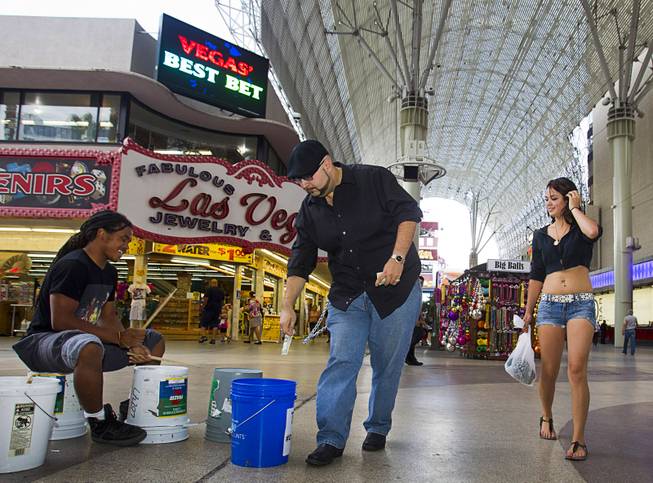
Chris Torres and Yvonne Armijo of Socorro, N.M., tip drummer JaRed Crawford, 17, a Las Vegas Academy senior, at Fremont Street Experience on Sunday, July 27, 2014, in downtown Las Vegas.
Monday, June 1, 2015 | 2 a.m.
On a recent Friday night, dozens of street performers spread out under the lights of the Fremont Street Experience delighting tourists with a photo or bit of amusement in exchange for tips.
Musicians, magicians, fake Elvises, showgirls and other costumed characters have been flocking to the pedestrian mall since it opened in 1995. For nearly as long, the city has cast a wary eye on their presence and has tried various measures to corral or outright ban the performers in the name of public safety and protecting the tourist experience.
The push and pull between the performers’ rights of expression and local governments’ pursuit of regulation has led to a series of court battles that largely have protected performers on Fremont Street and the Strip.
But that doesn’t mean local governments have no say in the matter.
As part of a continued effort to clean up Fremont Street that already has included a ban on glass containers and restrictions on package liquor sales, Las Vegas now is turning its attention to street performers with plans for a new ordinance meant to bring more order to the Fremont Street Experience.
The city has been working with casinos, street performers and the ACLU to craft new regulations to try to avoid protracted legal battles. Officials plan to introduce a formal ordinance for consideration by the City Council in the coming months.
The law
A series of court battles fought in Las Vegas and around the country have firmly established that street performers and buskers in public spaces are protected by the First Amendment. That means performers have a basic right to express themselves, and the government can’t discriminate against them, whether they’re posing for photos in costume or espousing political beliefs.
“You can’t say you’re allowed to come down here to play a saxophone because we like jazz but you can’t play the piccolo,” said Tod Story, executive director of ACLU Nevada. “If you have to allow one, you have to allow them all.”
Local governments do have some control, though, and street performers must comply with existing laws regarding obscenity, nudity and noise.
Governments also can impose “time, place and manner” restrictions, which can be used to limit where and how street performers operate. However, the rules must be crafted carefully to be the least restrictive means to ensure public safety and order.
For instance, Las Vegas passed rules in 2011 that require street performers to remain at least 10 to 20 feet away from kiosks, ATMs, outdoor cafes and crosswalks. The rules also limit the size of tables street performers can bring to Fremont Street.
On the Strip, Clark County created rules forbidding electrical generators, knives, fireworks and other potentially dangerous items that might be used by performers.
Potential changes
Despite the rules, chaos still can erupt on Fremont Street, as evidenced by stories about fights between performers and non-tipping tourists, and turf battles between performers eyeing the same spot on the mall.
“We have five years experience with that ordinance,” city attorney Brad Jerbic said. “Is it working? Is it not working? If it’s not, what can be done to fix it?”
The proposal being debated at city hall would flip the city’s current enforcement strategy. Instead of telling performers where they can’t be, the proposed rules would tell them where they can be by creating performance zones throughout the Fremont Street Experience.
The zones, currently imagined as 6-foot diameter circles, would be scattered and placed to avoid conflicting with high-traffic areas. Performers would sign up in advance for specific zones and would have to rotate to a new zone every hour to prevent conflicts over the spaces.
“It’s not anywhere near final, but that’s what we’re discussing,” Jerbic said. “This would hopefully give everybody a right to express their speech and give everybody an equal opportunity to perform.”
The city expects the rules, which are modeled after a similar strategy used in Santa Monica, will pass constitutional muster. Officials are working with the ACLU, street performers and businesses to craft a solution that can avoid a messy legal fight.
Another meeting between the groups is scheduled for June, and a formal ordinance could emerge this summer.
“Is there a way to make it less confusing, more uniform and easier for everyone to understand?” Story asked. “We’re all waiting to see what that’s going to look like. It comes down to: Where are these places going to be? Are they going to be in an alley somewhere? Are they going to be hidden behind a structure?”

Join the Discussion:
Check this out for a full explanation of our conversion to the LiveFyre commenting system and instructions on how to sign up for an account.
Full comments policy